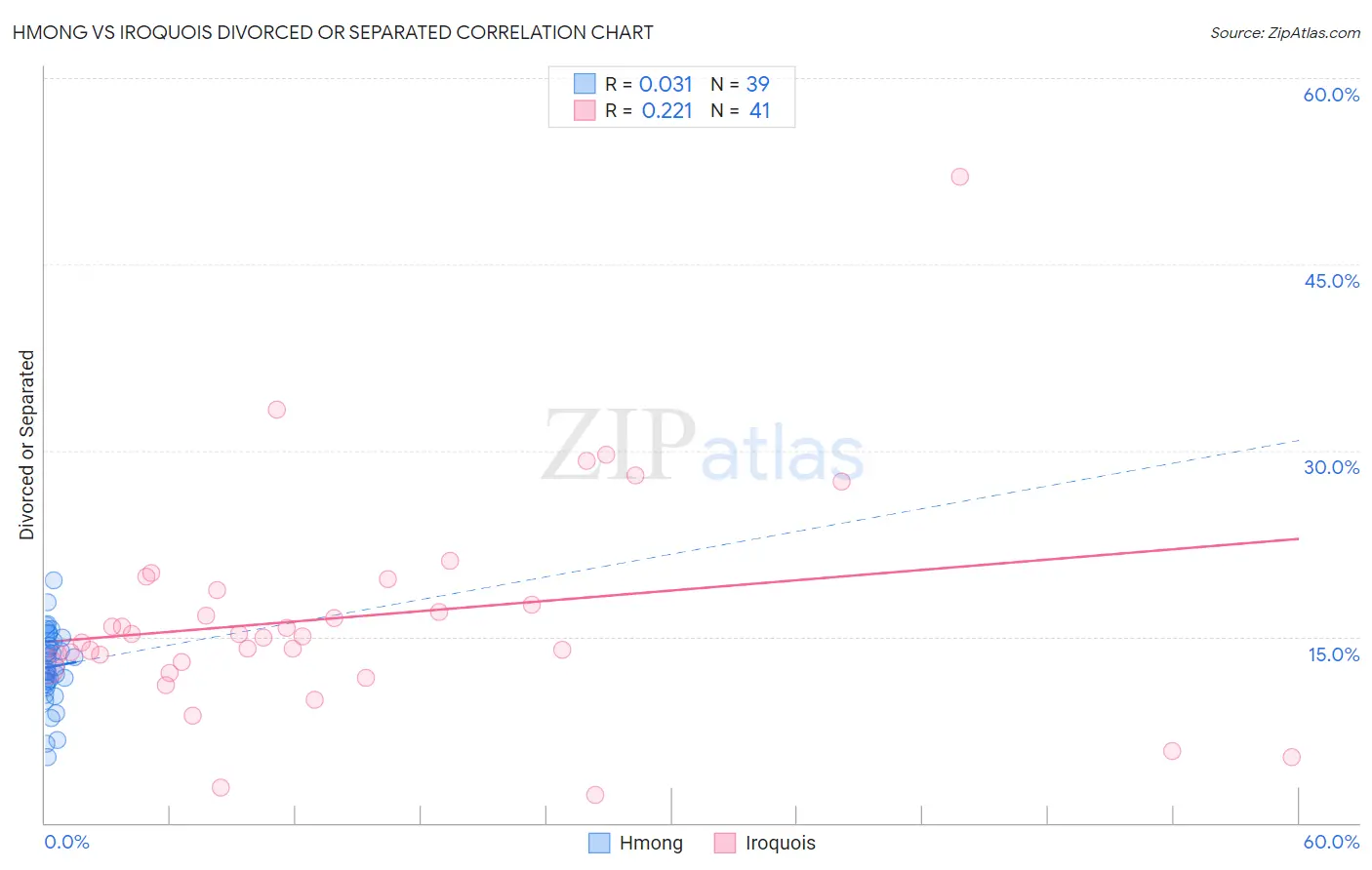Hmong vs Iroquois Divorced or Separated
COMPARE
Hmong
Iroquois
Divorced or Separated
Divorced or Separated Comparison
Hmong
Iroquois
12.3%
DIVORCED OR SEPARATED
8.8/ 100
METRIC RATING
227th/ 347
METRIC RANK
12.9%
DIVORCED OR SEPARATED
0.0/ 100
METRIC RATING
289th/ 347
METRIC RANK
Hmong vs Iroquois Divorced or Separated Correlation Chart
The statistical analysis conducted on geographies consisting of 24,678,157 people shows no correlation between the proportion of Hmong and percentage of population currently divorced or separated in the United States with a correlation coefficient (R) of 0.031 and weighted average of 12.3%. Similarly, the statistical analysis conducted on geographies consisting of 207,262,032 people shows a weak positive correlation between the proportion of Iroquois and percentage of population currently divorced or separated in the United States with a correlation coefficient (R) of 0.221 and weighted average of 12.9%, a difference of 4.6%.

Divorced or Separated Correlation Summary
| Measurement | Hmong | Iroquois |
| Minimum | 5.3% | 2.3% |
| Maximum | 19.5% | 52.0% |
| Range | 14.2% | 49.7% |
| Mean | 12.6% | 16.6% |
| Median | 12.6% | 15.0% |
| Interquartile 25% (IQ1) | 11.3% | 12.8% |
| Interquartile 75% (IQ3) | 14.6% | 19.2% |
| Interquartile Range (IQR) | 3.3% | 6.4% |
| Standard Deviation (Sample) | 3.0% | 8.8% |
| Standard Deviation (Population) | 2.9% | 8.7% |
Similar Demographics by Divorced or Separated
Demographics Similar to Hmong by Divorced or Separated
In terms of divorced or separated, the demographic groups most similar to Hmong are Immigrants from Western Africa (12.3%, a difference of 0.050%), Immigrants from Cameroon (12.3%, a difference of 0.050%), Immigrants from Sudan (12.3%, a difference of 0.070%), Immigrants from the Azores (12.3%, a difference of 0.090%), and Belgian (12.3%, a difference of 0.090%).
| Demographics | Rating | Rank | Divorced or Separated |
| British | 11.6 /100 | #220 | Poor 12.3% |
| Guamanians/Chamorros | 11.3 /100 | #221 | Poor 12.3% |
| Bangladeshis | 10.5 /100 | #222 | Poor 12.3% |
| Scandinavians | 10.4 /100 | #223 | Poor 12.3% |
| Immigrants | Azores | 9.7 /100 | #224 | Tragic 12.3% |
| Belgians | 9.7 /100 | #225 | Tragic 12.3% |
| Immigrants | Western Africa | 9.3 /100 | #226 | Tragic 12.3% |
| Hmong | 8.8 /100 | #227 | Tragic 12.3% |
| Immigrants | Cameroon | 8.3 /100 | #228 | Tragic 12.3% |
| Immigrants | Sudan | 8.2 /100 | #229 | Tragic 12.3% |
| Yakama | 7.8 /100 | #230 | Tragic 12.3% |
| Yugoslavians | 6.6 /100 | #231 | Tragic 12.3% |
| Canadians | 5.3 /100 | #232 | Tragic 12.4% |
| Malaysians | 4.8 /100 | #233 | Tragic 12.4% |
| West Indians | 4.4 /100 | #234 | Tragic 12.4% |
Demographics Similar to Iroquois by Divorced or Separated
In terms of divorced or separated, the demographic groups most similar to Iroquois are Pima (12.9%, a difference of 0.14%), French Canadian (12.8%, a difference of 0.15%), Immigrants from Honduras (12.9%, a difference of 0.26%), Scotch-Irish (12.9%, a difference of 0.32%), and Honduran (12.8%, a difference of 0.41%).
| Demographics | Rating | Rank | Divorced or Separated |
| Sub-Saharan Africans | 0.1 /100 | #282 | Tragic 12.7% |
| Delaware | 0.1 /100 | #283 | Tragic 12.7% |
| Immigrants | Nonimmigrants | 0.1 /100 | #284 | Tragic 12.8% |
| French | 0.1 /100 | #285 | Tragic 12.8% |
| Spanish | 0.1 /100 | #286 | Tragic 12.8% |
| Hondurans | 0.1 /100 | #287 | Tragic 12.8% |
| French Canadians | 0.1 /100 | #288 | Tragic 12.8% |
| Iroquois | 0.0 /100 | #289 | Tragic 12.9% |
| Pima | 0.0 /100 | #290 | Tragic 12.9% |
| Immigrants | Honduras | 0.0 /100 | #291 | Tragic 12.9% |
| Scotch-Irish | 0.0 /100 | #292 | Tragic 12.9% |
| Jamaicans | 0.0 /100 | #293 | Tragic 12.9% |
| Apache | 0.0 /100 | #294 | Tragic 12.9% |
| Celtics | 0.0 /100 | #295 | Tragic 13.0% |
| Nicaraguans | 0.0 /100 | #296 | Tragic 13.0% |